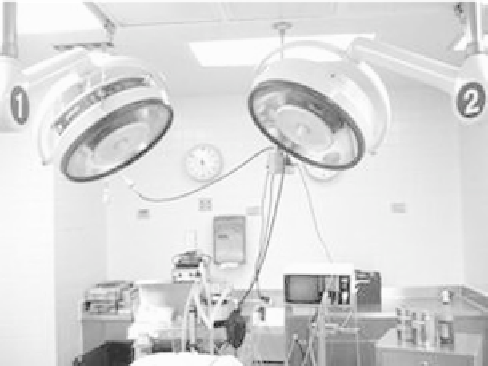Biomedical Engineering Reference
In-Depth Information
motion, working from the planned incision site outward to
the periphery, should be used, making certain that an
excess of scrubbed area is prepped (
Shmon, 2003
). The
veterinary technician may scrub the surgical site while
the surgeons scrub, then assist the surgeons in draping the
animal. The authors prefer to use four corner draping with
sterilized cloth towels, followed by the use of a large table
drape covering the entire animal, providing a sterile field
extending to the instrument table. Alternatively, one may
use disposable, impervious towels available from multiple
sources. Either a fenestrated table drape or simply cutting
the opening over the draped surgical site may be used.
Clear, adhesive drapes, used in avian and exotic medicine
come in handy for small nonhuman primates. If extensive
intraoperative irrigation is planned, a protective sheet of
plastic should be placed under the surgical drape to
prevent the animal from getting wet, which may result in
hypothermia. Supplemental heating devices are strongly
recommended (see
Intraoperative Considerations
Surgery is never a trivial event and it requires meticulous
preparations. The importance of proper training for
researchers cannot be overemphasized. Training should
focus on aseptic techniques, gentle tissue handling, minimal
dissection of tissue, appropriate use of instruments, effective
hemostasis, and correct use of suture materials and patterns
(
Brown et al., 1993; Heon et al., 2006
).
Vital Signs
The surgeon relies on the anesthesiologist's expertise to
create the right equilibrium of immobility, muscle relaxation,
and analgesia. The surgeon, however, should observe acces-
sible, crucial vital signs in the subject's through constant
evaluation and share them with the anesthesiologist. Such
communication is key in handling important intraoperative
events. For instance, opening clamps to allow reperfusion of
a transplanted liver might lead to hypovolemia and hypo-
tension which require pre-emptive fluid preload. Tissue
blanching may be indicative of hemorrhage, hypovolemia,
hypotension, or hypothermia. Tissue temperature changes
may signal hypo- or hyperthermia, whereas muscular
fasciculations or twitching may point to insufficient anes-
thesia/analgesia or central nervous system deficit.
the
section “Thermoregulation”
below).
Illumination
Excellent lighting is critical for effective surgery. Use of
sterilized light handles, to allow the surgeon to manipulate
the lights, is advantageous. The authors recommend
surgical lights that provide cool, shadow-reduced and
color-corrected light, prevent direct glare, and are easy to
maneuver and position (
Figure 14.1
).
Hemostasis
Hemostasis is desirable for proper intraoperative visibility
and critical for subject's health. Methods include:
Sterilization Techniques
Surgical instruments and select supplies such as gauze and
towels can be sterilized using steam autoclave. Items that
cannot withstand high temperatures should be sterilized
using ethylene oxide, plasma H
2
O
2
sterilizers, or a 10-hour
soak in cold glutaraldehyde preparations (Cidex
or
equivalent).
Local pressure
surgeon's finger, Q tip, gauze, forceps,
hemostat, temporary or permanent ligature.
e
l
Electro-cauterization
useful in areas of capillary
seepage (skin, subcutaneous layers, cross-sections
through solid organs such as liver or kidney) but inef-
fective on large bleeding vessels.
e
l
Absorbant hemostatic agents
Gelfoam, Surgicel,
cellulose surgical spears (
Hampshire and Gonder,
2007b
).
e
l
Mechanical tamponade materials
e
bone wax.
l
Suction
useful in blood or fluid removal to facilitate
better visualization as well as evacuation of smoke
generated by electrocautery.
e
l
Hydration
Intraoperative fluids, typically sterile 0.9% NaCl or lactated
Ringer's infused at 5
10 ml/kg/h i.v. to animals under
stable anesthesia, will meet most nonemergency fluid
demands and provide extra volume in mild to moderate
blood pressure decreases. Other fluid types may be required
by the particular health status of the animal, and it may be
advisable to supplement glucose in lengthy procedures on
smaller nonhuman primates (for more details see Chapters
15 and 17).
e
FIGURE 14.1
Ceiling mounted surgical lights.





